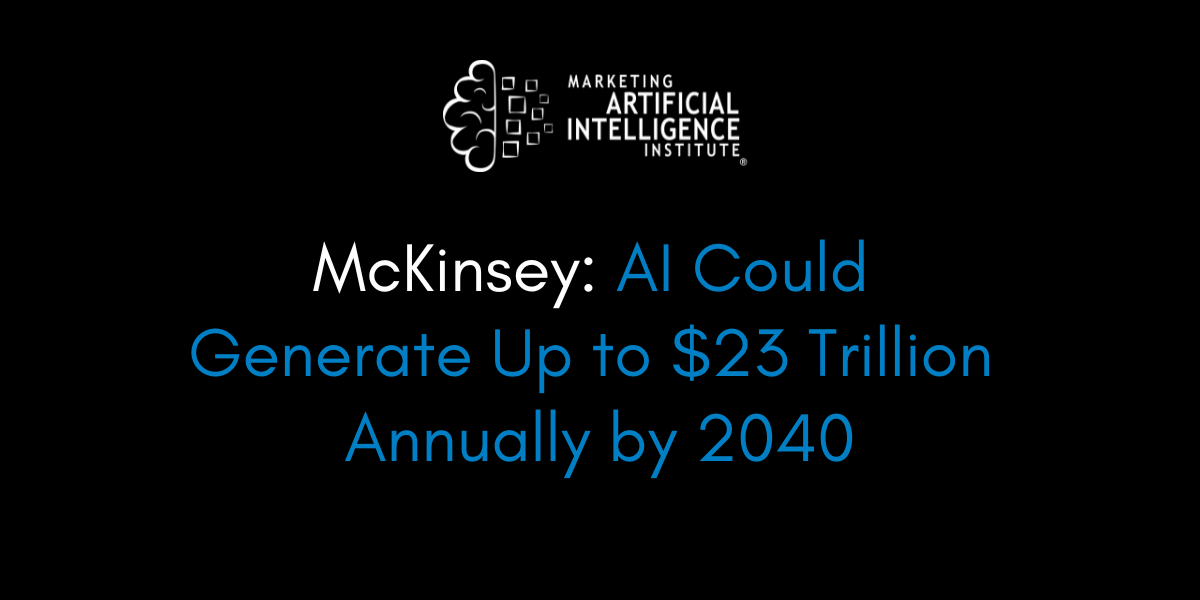McKinsey just dropped a massive 213-page report about the future of the global economy, and the numbers for AI are staggering:
AI software and services alone could generate up to $23 trillion in annual economic value by 2040.
But here's the kicker:
We might actually be underestimating the impact.
I broke down what these mind-boggling numbers really mean with Marketing AI Institute founder and CEO Paul Roetzer on Episode 122 of The Artificial Intelligence Show.
The Numbers That Have Everyone Talking
McKinsey's "The Next Big Arenas of Competition" report identifies 18 future “arenas” that could reshape the global economy, which are basically high-growth sectors that could have an outsized impact on the business landscape.
One of these arenas is AI Software and Services. And boy is this area booming:
- Equity investments in generative AI jumped from $5 billion in 2022 to $36 billion in 2023.
- McKinsey’s low estimate has AI Software and Services revenue growing from $85 billion in 2022 to $1.5 trillion in 2040. (And the higher-end estimate is it could grow to $4.6 trillion.)
- Generative AI alone could product $2.6 trillion to $4.4 trillion of economic impact through enterprise use cases, with 75% of that value in just four areas: customer operations, marketing and sales, software engineering, and R&D.
And the final whopping stat?
When adding together all the components McKinsey analyzed, they predict AI Software and Services has a total economic potential of $15.5 trillion to $22.9 trillion annually by 2040.
Putting Trillions in Perspective
To understand just how massive these numbers are, consider this context from Roetzer:
US GDP was right around $28 trillion as of October 2024. So the amounts we’re talking about are equivalent to the size of the world’s largest economy.
Now, traditional economists are skeptical of AI driving massive GDP growth, as GDP typically grows 2.5-3% annually. But Roetzer identifies several ways AI could drive unprecedented growth:
- Increased productivity: AI enables humans to produce more goods and services, and efficiency gains create more output capacity.
- Innovation acceleration: AI helps identify new markets, speeds up product development, and drives faster innovation cycles.
- Labor force reallocation. As AI increasingly helps perform cognitive labor, there’s the potential that knowledge workers can be redistributed to do other, more valuable things.
- Industry growth. AI enables entire sectors to produce more, and creates new markets and opportunities
- Enhanced consumer demand. Better personalization drives consumption and more efficient markets increase spending.
“These are all fundamental, tangible ways that you can start to make an argument that AI will have a massive economic impact on GDP,” says Roetzer.
The Hidden Variable: Superintelligence
Not to mention, there’s a hidden variable that most forecasters—including McKinsey—miss:
They don’t fully account for the impact of smarter and smarter models, all the way up to artificial general intelligence (AGI) or superintelligence.
“This is one of the big flaws we see from researchers and economists: they’re not considering the future models,” says Roetzer. “They’re considering what we know to be true about current models.”
When you consider what might soon be possible, the picture changes. For instance, ex-OpenAI researcher Leopold Aschenbrenner suggests we could see economic growth rates of 30% per year or more once superintelligence arrives—potentially even doubling each year.
However, there's a catch.
"This may well be delayed by societal frictions," notes Roetzer, citing Aschenbrenner's research. Recent examples include labor disputes over port automation—showing how social and regulatory friction could slow AI's economic impact.
What This Means for Business Leaders
While the exact numbers may be debatable, the direction is clear: AI's economic impact will be massive, and we're just getting started.
Not to mention, the specific projections matter less than the clear trajectory. We know the models are getting smarter. We know they’re already starting to impact knowledge work. So it doesn’t matter if the impact is $1 trillion or $10 trillion or $100 trillion.
“The key takeaway here is: the impact is huge,” says Roetzer. “It's trillions. And we're just at the start.”
So, what do you do about that?
Roetzer’s advice is very simple:
“Default to taking action every day,” he says. “The people who take action and accelerate their literacy and capabilities have the greatest chance of thriving as we move forward, and the same holds true for businesses.”
Mike Kaput
As Chief Content Officer, Mike Kaput uses content marketing, marketing strategy, and marketing technology to grow and scale traffic, leads, and revenue for Marketing AI Institute. Mike is the co-author of Marketing Artificial Intelligence: AI, Marketing and the Future of Business (Matt Holt Books, 2022). See Mike's full bio.


